Case Study: Perioperative Nursing and Patient Safety in Spine Surgery
VerifiedAdded on 2022/12/30
|6
|1807
|91
Case Study
AI Summary
This case study examines a perioperative nursing scenario involving a patient, Ms. Sally Winston, who developed red marks and a burning sensation on her face after undergoing extensive spinal surgery in the prone position. The assignment identifies the patient safety issue as skin complications, likely due to prolonged pressure, contact with surgical materials, or pre-existing skin sensitivity. It explores the frequency of such issues, the impact on patients, including discomfort and potential skin damage, and strategies to mitigate these risks. Prevention strategies discussed include careful patient positioning, thorough cleaning of the operating table, pre-operative assessment of skin sensitivity, and the use of protective measures like dressings or ointments. The case study emphasizes the importance of proactive measures to minimize the occurrence of these complications and ensure patient well-being during and after surgery.
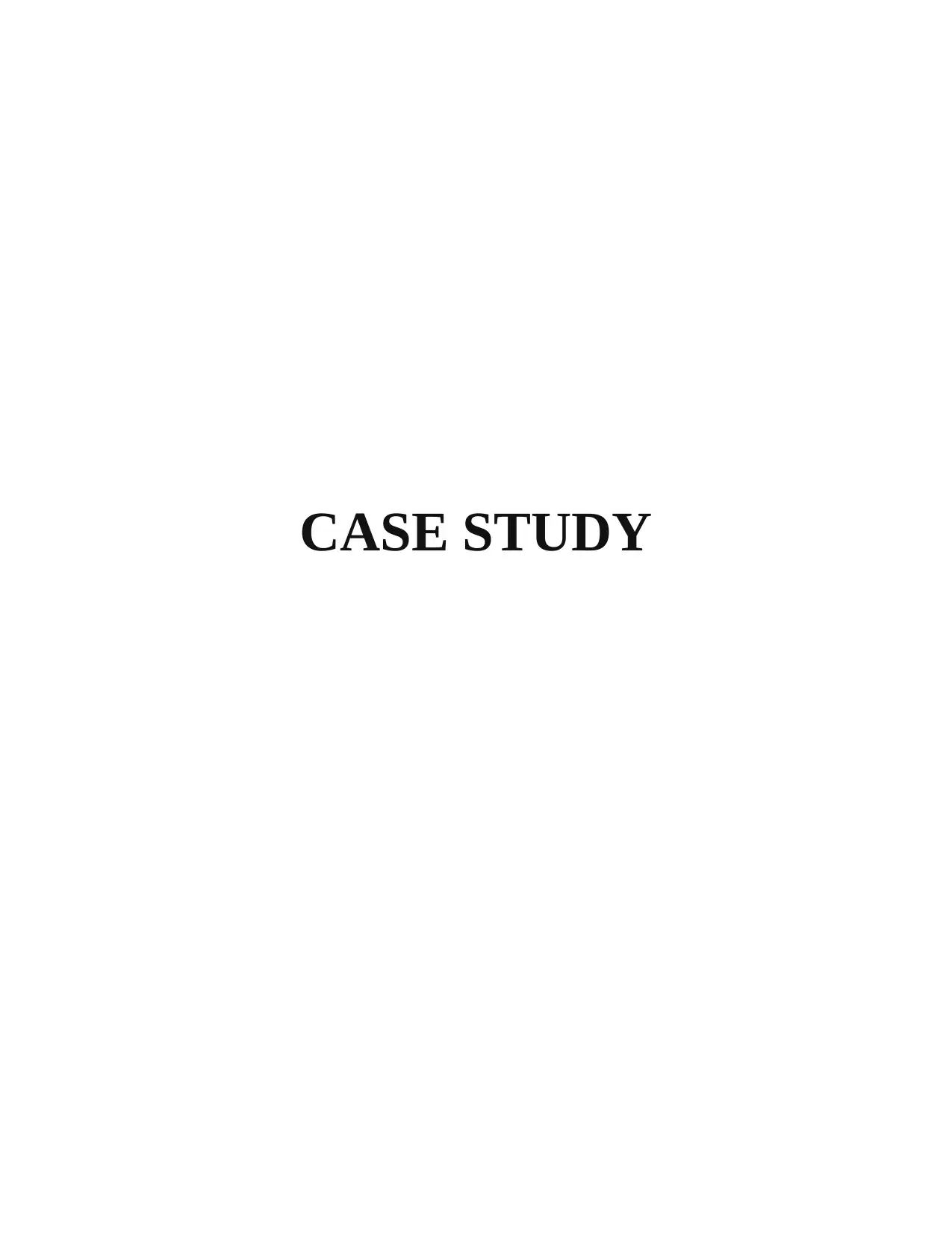
CASE STUDY
Paraphrase This Document
Need a fresh take? Get an instant paraphrase of this document with our AI Paraphraser
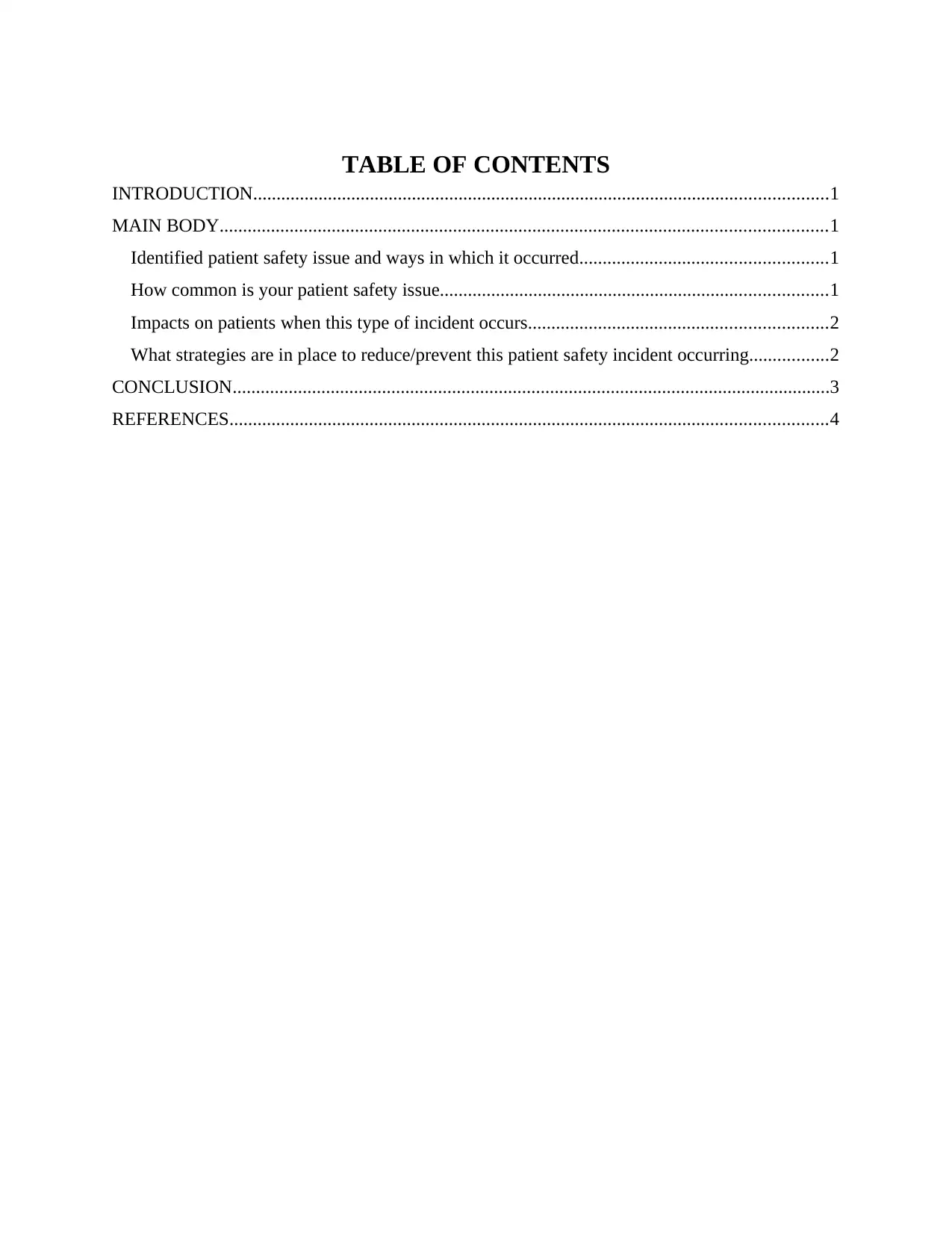
TABLE OF CONTENTS
INTRODUCTION...........................................................................................................................1
MAIN BODY..................................................................................................................................1
Identified patient safety issue and ways in which it occurred.....................................................1
How common is your patient safety issue...................................................................................1
Impacts on patients when this type of incident occurs................................................................2
What strategies are in place to reduce/prevent this patient safety incident occurring.................2
CONCLUSION................................................................................................................................3
REFERENCES................................................................................................................................4
INTRODUCTION...........................................................................................................................1
MAIN BODY..................................................................................................................................1
Identified patient safety issue and ways in which it occurred.....................................................1
How common is your patient safety issue...................................................................................1
Impacts on patients when this type of incident occurs................................................................2
What strategies are in place to reduce/prevent this patient safety incident occurring.................2
CONCLUSION................................................................................................................................3
REFERENCES................................................................................................................................4
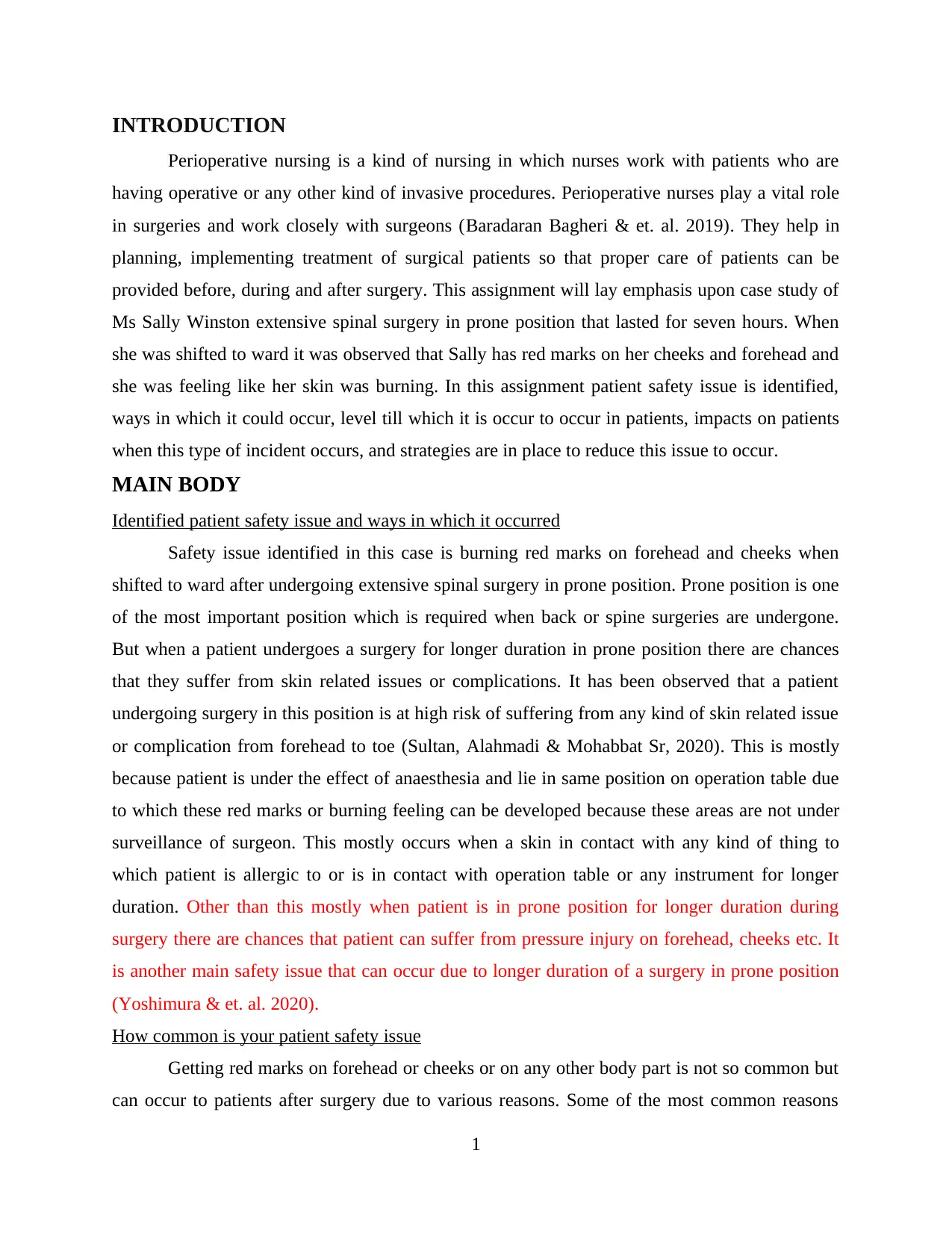
INTRODUCTION
Perioperative nursing is a kind of nursing in which nurses work with patients who are
having operative or any other kind of invasive procedures. Perioperative nurses play a vital role
in surgeries and work closely with surgeons (Baradaran Bagheri & et. al. 2019). They help in
planning, implementing treatment of surgical patients so that proper care of patients can be
provided before, during and after surgery. This assignment will lay emphasis upon case study of
Ms Sally Winston extensive spinal surgery in prone position that lasted for seven hours. When
she was shifted to ward it was observed that Sally has red marks on her cheeks and forehead and
she was feeling like her skin was burning. In this assignment patient safety issue is identified,
ways in which it could occur, level till which it is occur to occur in patients, impacts on patients
when this type of incident occurs, and strategies are in place to reduce this issue to occur.
MAIN BODY
Identified patient safety issue and ways in which it occurred
Safety issue identified in this case is burning red marks on forehead and cheeks when
shifted to ward after undergoing extensive spinal surgery in prone position. Prone position is one
of the most important position which is required when back or spine surgeries are undergone.
But when a patient undergoes a surgery for longer duration in prone position there are chances
that they suffer from skin related issues or complications. It has been observed that a patient
undergoing surgery in this position is at high risk of suffering from any kind of skin related issue
or complication from forehead to toe (Sultan, Alahmadi & Mohabbat Sr, 2020). This is mostly
because patient is under the effect of anaesthesia and lie in same position on operation table due
to which these red marks or burning feeling can be developed because these areas are not under
surveillance of surgeon. This mostly occurs when a skin in contact with any kind of thing to
which patient is allergic to or is in contact with operation table or any instrument for longer
duration. Other than this mostly when patient is in prone position for longer duration during
surgery there are chances that patient can suffer from pressure injury on forehead, cheeks etc. It
is another main safety issue that can occur due to longer duration of a surgery in prone position
(Yoshimura & et. al. 2020).
How common is your patient safety issue
Getting red marks on forehead or cheeks or on any other body part is not so common but
can occur to patients after surgery due to various reasons. Some of the most common reasons
1
Perioperative nursing is a kind of nursing in which nurses work with patients who are
having operative or any other kind of invasive procedures. Perioperative nurses play a vital role
in surgeries and work closely with surgeons (Baradaran Bagheri & et. al. 2019). They help in
planning, implementing treatment of surgical patients so that proper care of patients can be
provided before, during and after surgery. This assignment will lay emphasis upon case study of
Ms Sally Winston extensive spinal surgery in prone position that lasted for seven hours. When
she was shifted to ward it was observed that Sally has red marks on her cheeks and forehead and
she was feeling like her skin was burning. In this assignment patient safety issue is identified,
ways in which it could occur, level till which it is occur to occur in patients, impacts on patients
when this type of incident occurs, and strategies are in place to reduce this issue to occur.
MAIN BODY
Identified patient safety issue and ways in which it occurred
Safety issue identified in this case is burning red marks on forehead and cheeks when
shifted to ward after undergoing extensive spinal surgery in prone position. Prone position is one
of the most important position which is required when back or spine surgeries are undergone.
But when a patient undergoes a surgery for longer duration in prone position there are chances
that they suffer from skin related issues or complications. It has been observed that a patient
undergoing surgery in this position is at high risk of suffering from any kind of skin related issue
or complication from forehead to toe (Sultan, Alahmadi & Mohabbat Sr, 2020). This is mostly
because patient is under the effect of anaesthesia and lie in same position on operation table due
to which these red marks or burning feeling can be developed because these areas are not under
surveillance of surgeon. This mostly occurs when a skin in contact with any kind of thing to
which patient is allergic to or is in contact with operation table or any instrument for longer
duration. Other than this mostly when patient is in prone position for longer duration during
surgery there are chances that patient can suffer from pressure injury on forehead, cheeks etc. It
is another main safety issue that can occur due to longer duration of a surgery in prone position
(Yoshimura & et. al. 2020).
How common is your patient safety issue
Getting red marks on forehead or cheeks or on any other body part is not so common but
can occur to patients after surgery due to various reasons. Some of the most common reasons
1
⊘ This is a preview!⊘
Do you want full access?
Subscribe today to unlock all pages.

Trusted by 1+ million students worldwide
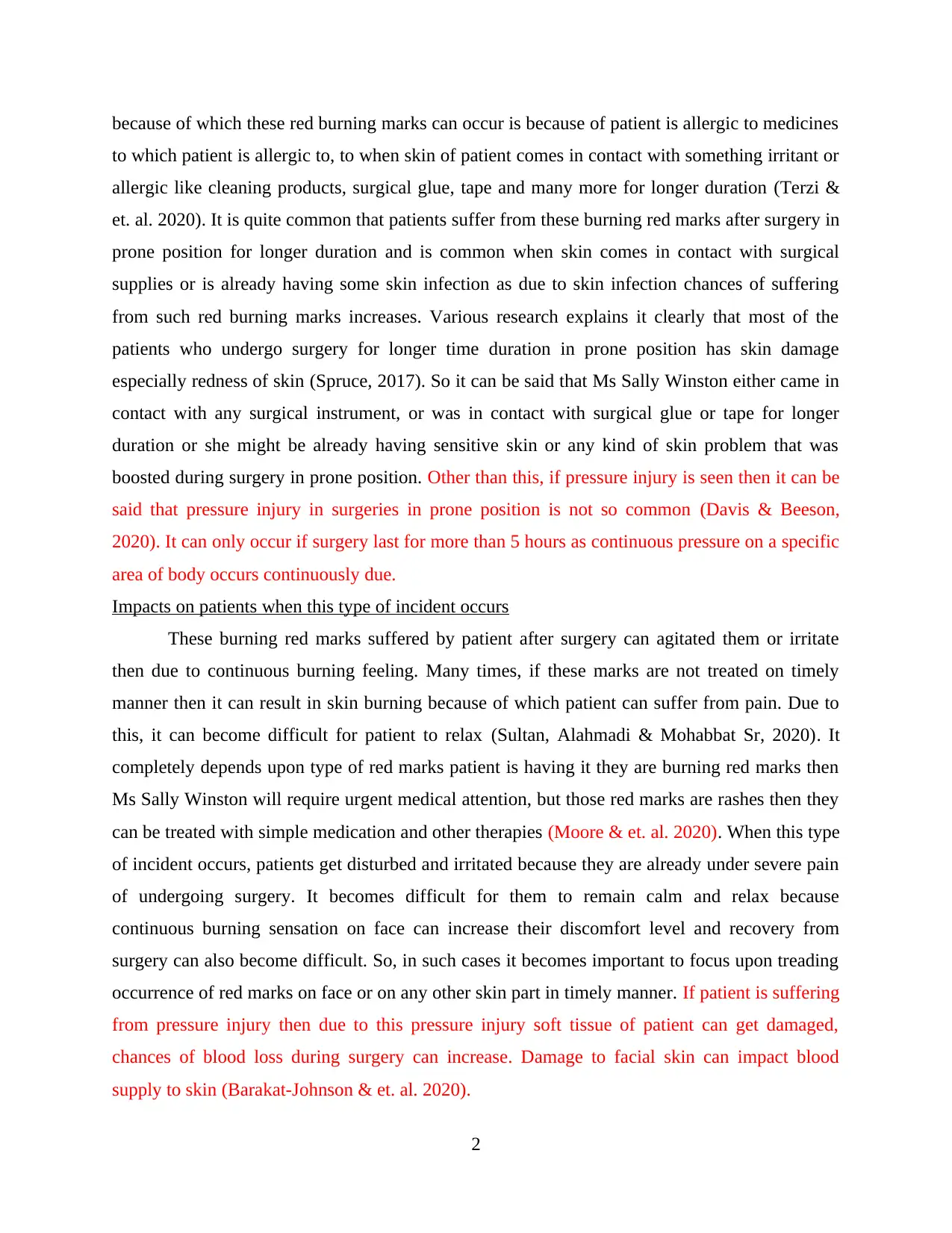
because of which these red burning marks can occur is because of patient is allergic to medicines
to which patient is allergic to, to when skin of patient comes in contact with something irritant or
allergic like cleaning products, surgical glue, tape and many more for longer duration (Terzi &
et. al. 2020). It is quite common that patients suffer from these burning red marks after surgery in
prone position for longer duration and is common when skin comes in contact with surgical
supplies or is already having some skin infection as due to skin infection chances of suffering
from such red burning marks increases. Various research explains it clearly that most of the
patients who undergo surgery for longer time duration in prone position has skin damage
especially redness of skin (Spruce, 2017). So it can be said that Ms Sally Winston either came in
contact with any surgical instrument, or was in contact with surgical glue or tape for longer
duration or she might be already having sensitive skin or any kind of skin problem that was
boosted during surgery in prone position. Other than this, if pressure injury is seen then it can be
said that pressure injury in surgeries in prone position is not so common (Davis & Beeson,
2020). It can only occur if surgery last for more than 5 hours as continuous pressure on a specific
area of body occurs continuously due.
Impacts on patients when this type of incident occurs
These burning red marks suffered by patient after surgery can agitated them or irritate
then due to continuous burning feeling. Many times, if these marks are not treated on timely
manner then it can result in skin burning because of which patient can suffer from pain. Due to
this, it can become difficult for patient to relax (Sultan, Alahmadi & Mohabbat Sr, 2020). It
completely depends upon type of red marks patient is having it they are burning red marks then
Ms Sally Winston will require urgent medical attention, but those red marks are rashes then they
can be treated with simple medication and other therapies (Moore & et. al. 2020). When this type
of incident occurs, patients get disturbed and irritated because they are already under severe pain
of undergoing surgery. It becomes difficult for them to remain calm and relax because
continuous burning sensation on face can increase their discomfort level and recovery from
surgery can also become difficult. So, in such cases it becomes important to focus upon treading
occurrence of red marks on face or on any other skin part in timely manner. If patient is suffering
from pressure injury then due to this pressure injury soft tissue of patient can get damaged,
chances of blood loss during surgery can increase. Damage to facial skin can impact blood
supply to skin (Barakat-Johnson & et. al. 2020).
2
to which patient is allergic to, to when skin of patient comes in contact with something irritant or
allergic like cleaning products, surgical glue, tape and many more for longer duration (Terzi &
et. al. 2020). It is quite common that patients suffer from these burning red marks after surgery in
prone position for longer duration and is common when skin comes in contact with surgical
supplies or is already having some skin infection as due to skin infection chances of suffering
from such red burning marks increases. Various research explains it clearly that most of the
patients who undergo surgery for longer time duration in prone position has skin damage
especially redness of skin (Spruce, 2017). So it can be said that Ms Sally Winston either came in
contact with any surgical instrument, or was in contact with surgical glue or tape for longer
duration or she might be already having sensitive skin or any kind of skin problem that was
boosted during surgery in prone position. Other than this, if pressure injury is seen then it can be
said that pressure injury in surgeries in prone position is not so common (Davis & Beeson,
2020). It can only occur if surgery last for more than 5 hours as continuous pressure on a specific
area of body occurs continuously due.
Impacts on patients when this type of incident occurs
These burning red marks suffered by patient after surgery can agitated them or irritate
then due to continuous burning feeling. Many times, if these marks are not treated on timely
manner then it can result in skin burning because of which patient can suffer from pain. Due to
this, it can become difficult for patient to relax (Sultan, Alahmadi & Mohabbat Sr, 2020). It
completely depends upon type of red marks patient is having it they are burning red marks then
Ms Sally Winston will require urgent medical attention, but those red marks are rashes then they
can be treated with simple medication and other therapies (Moore & et. al. 2020). When this type
of incident occurs, patients get disturbed and irritated because they are already under severe pain
of undergoing surgery. It becomes difficult for them to remain calm and relax because
continuous burning sensation on face can increase their discomfort level and recovery from
surgery can also become difficult. So, in such cases it becomes important to focus upon treading
occurrence of red marks on face or on any other skin part in timely manner. If patient is suffering
from pressure injury then due to this pressure injury soft tissue of patient can get damaged,
chances of blood loss during surgery can increase. Damage to facial skin can impact blood
supply to skin (Barakat-Johnson & et. al. 2020).
2
Paraphrase This Document
Need a fresh take? Get an instant paraphrase of this document with our AI Paraphraser
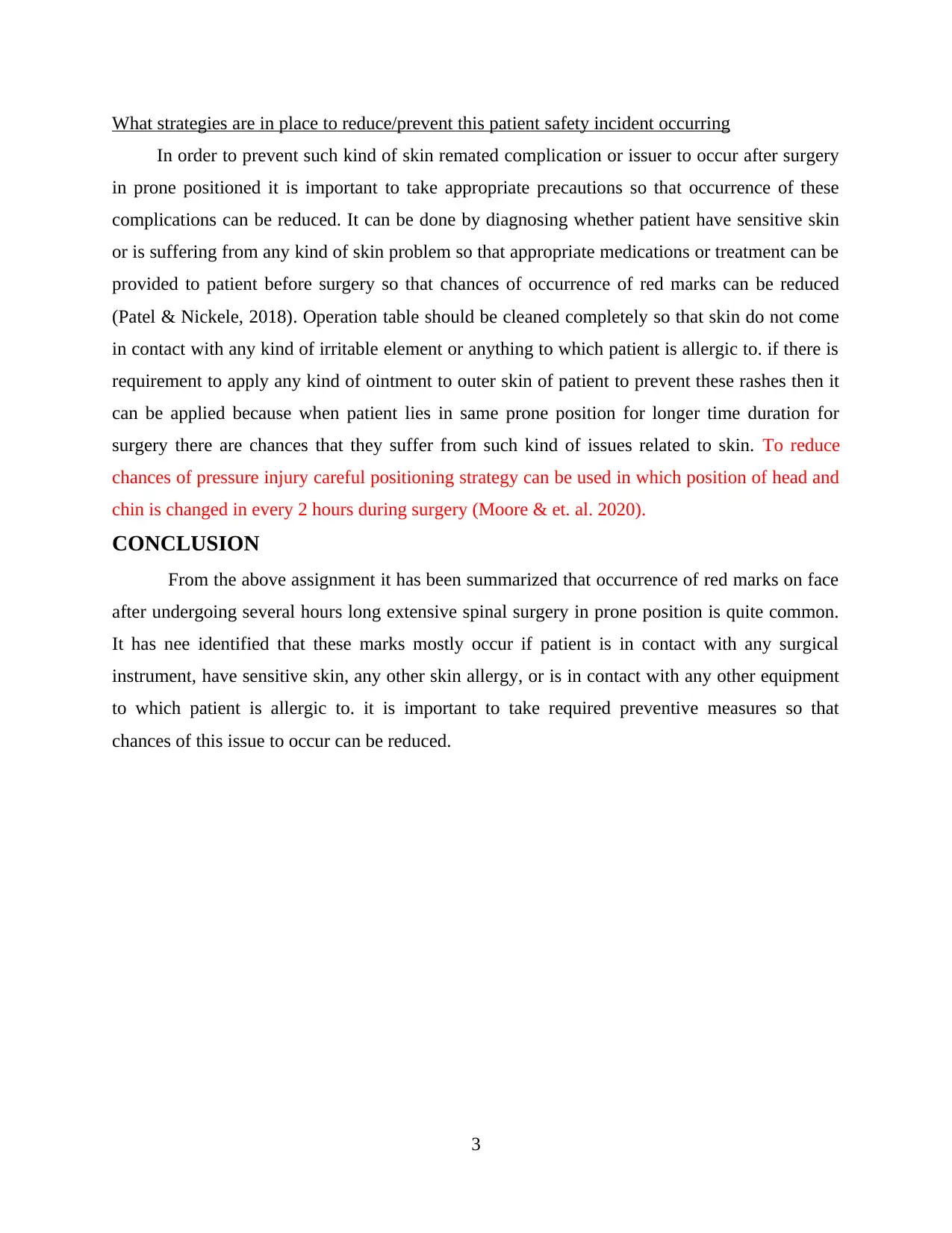
What strategies are in place to reduce/prevent this patient safety incident occurring
In order to prevent such kind of skin remated complication or issuer to occur after surgery
in prone positioned it is important to take appropriate precautions so that occurrence of these
complications can be reduced. It can be done by diagnosing whether patient have sensitive skin
or is suffering from any kind of skin problem so that appropriate medications or treatment can be
provided to patient before surgery so that chances of occurrence of red marks can be reduced
(Patel & Nickele, 2018). Operation table should be cleaned completely so that skin do not come
in contact with any kind of irritable element or anything to which patient is allergic to. if there is
requirement to apply any kind of ointment to outer skin of patient to prevent these rashes then it
can be applied because when patient lies in same prone position for longer time duration for
surgery there are chances that they suffer from such kind of issues related to skin. To reduce
chances of pressure injury careful positioning strategy can be used in which position of head and
chin is changed in every 2 hours during surgery (Moore & et. al. 2020).
CONCLUSION
From the above assignment it has been summarized that occurrence of red marks on face
after undergoing several hours long extensive spinal surgery in prone position is quite common.
It has nee identified that these marks mostly occur if patient is in contact with any surgical
instrument, have sensitive skin, any other skin allergy, or is in contact with any other equipment
to which patient is allergic to. it is important to take required preventive measures so that
chances of this issue to occur can be reduced.
3
In order to prevent such kind of skin remated complication or issuer to occur after surgery
in prone positioned it is important to take appropriate precautions so that occurrence of these
complications can be reduced. It can be done by diagnosing whether patient have sensitive skin
or is suffering from any kind of skin problem so that appropriate medications or treatment can be
provided to patient before surgery so that chances of occurrence of red marks can be reduced
(Patel & Nickele, 2018). Operation table should be cleaned completely so that skin do not come
in contact with any kind of irritable element or anything to which patient is allergic to. if there is
requirement to apply any kind of ointment to outer skin of patient to prevent these rashes then it
can be applied because when patient lies in same prone position for longer time duration for
surgery there are chances that they suffer from such kind of issues related to skin. To reduce
chances of pressure injury careful positioning strategy can be used in which position of head and
chin is changed in every 2 hours during surgery (Moore & et. al. 2020).
CONCLUSION
From the above assignment it has been summarized that occurrence of red marks on face
after undergoing several hours long extensive spinal surgery in prone position is quite common.
It has nee identified that these marks mostly occur if patient is in contact with any surgical
instrument, have sensitive skin, any other skin allergy, or is in contact with any other equipment
to which patient is allergic to. it is important to take required preventive measures so that
chances of this issue to occur can be reduced.
3
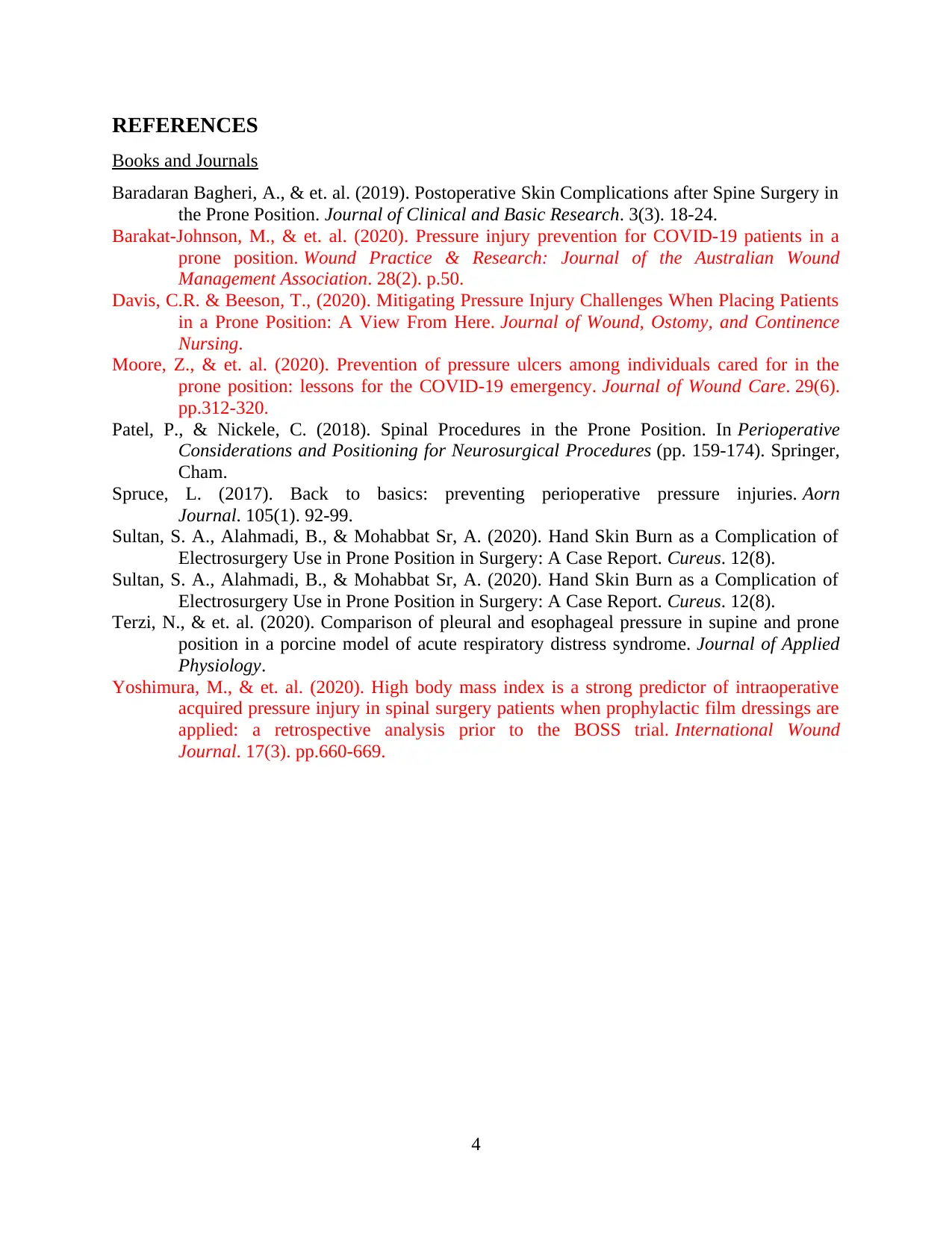
REFERENCES
Books and Journals
Baradaran Bagheri, A., & et. al. (2019). Postoperative Skin Complications after Spine Surgery in
the Prone Position. Journal of Clinical and Basic Research. 3(3). 18-24.
Barakat-Johnson, M., & et. al. (2020). Pressure injury prevention for COVID-19 patients in a
prone position. Wound Practice & Research: Journal of the Australian Wound
Management Association. 28(2). p.50.
Davis, C.R. & Beeson, T., (2020). Mitigating Pressure Injury Challenges When Placing Patients
in a Prone Position: A View From Here. Journal of Wound, Ostomy, and Continence
Nursing.
Moore, Z., & et. al. (2020). Prevention of pressure ulcers among individuals cared for in the
prone position: lessons for the COVID-19 emergency. Journal of Wound Care. 29(6).
pp.312-320.
Patel, P., & Nickele, C. (2018). Spinal Procedures in the Prone Position. In Perioperative
Considerations and Positioning for Neurosurgical Procedures (pp. 159-174). Springer,
Cham.
Spruce, L. (2017). Back to basics: preventing perioperative pressure injuries. Aorn
Journal. 105(1). 92-99.
Sultan, S. A., Alahmadi, B., & Mohabbat Sr, A. (2020). Hand Skin Burn as a Complication of
Electrosurgery Use in Prone Position in Surgery: A Case Report. Cureus. 12(8).
Sultan, S. A., Alahmadi, B., & Mohabbat Sr, A. (2020). Hand Skin Burn as a Complication of
Electrosurgery Use in Prone Position in Surgery: A Case Report. Cureus. 12(8).
Terzi, N., & et. al. (2020). Comparison of pleural and esophageal pressure in supine and prone
position in a porcine model of acute respiratory distress syndrome. Journal of Applied
Physiology.
Yoshimura, M., & et. al. (2020). High body mass index is a strong predictor of intraoperative
acquired pressure injury in spinal surgery patients when prophylactic film dressings are
applied: a retrospective analysis prior to the BOSS trial. International Wound
Journal. 17(3). pp.660-669.
4
Books and Journals
Baradaran Bagheri, A., & et. al. (2019). Postoperative Skin Complications after Spine Surgery in
the Prone Position. Journal of Clinical and Basic Research. 3(3). 18-24.
Barakat-Johnson, M., & et. al. (2020). Pressure injury prevention for COVID-19 patients in a
prone position. Wound Practice & Research: Journal of the Australian Wound
Management Association. 28(2). p.50.
Davis, C.R. & Beeson, T., (2020). Mitigating Pressure Injury Challenges When Placing Patients
in a Prone Position: A View From Here. Journal of Wound, Ostomy, and Continence
Nursing.
Moore, Z., & et. al. (2020). Prevention of pressure ulcers among individuals cared for in the
prone position: lessons for the COVID-19 emergency. Journal of Wound Care. 29(6).
pp.312-320.
Patel, P., & Nickele, C. (2018). Spinal Procedures in the Prone Position. In Perioperative
Considerations and Positioning for Neurosurgical Procedures (pp. 159-174). Springer,
Cham.
Spruce, L. (2017). Back to basics: preventing perioperative pressure injuries. Aorn
Journal. 105(1). 92-99.
Sultan, S. A., Alahmadi, B., & Mohabbat Sr, A. (2020). Hand Skin Burn as a Complication of
Electrosurgery Use in Prone Position in Surgery: A Case Report. Cureus. 12(8).
Sultan, S. A., Alahmadi, B., & Mohabbat Sr, A. (2020). Hand Skin Burn as a Complication of
Electrosurgery Use in Prone Position in Surgery: A Case Report. Cureus. 12(8).
Terzi, N., & et. al. (2020). Comparison of pleural and esophageal pressure in supine and prone
position in a porcine model of acute respiratory distress syndrome. Journal of Applied
Physiology.
Yoshimura, M., & et. al. (2020). High body mass index is a strong predictor of intraoperative
acquired pressure injury in spinal surgery patients when prophylactic film dressings are
applied: a retrospective analysis prior to the BOSS trial. International Wound
Journal. 17(3). pp.660-669.
4
⊘ This is a preview!⊘
Do you want full access?
Subscribe today to unlock all pages.

Trusted by 1+ million students worldwide
1 out of 6
Your All-in-One AI-Powered Toolkit for Academic Success.
+13062052269
info@desklib.com
Available 24*7 on WhatsApp / Email
![[object Object]](/_next/static/media/star-bottom.7253800d.svg)
Unlock your academic potential
Copyright © 2020–2025 A2Z Services. All Rights Reserved. Developed and managed by ZUCOL.
